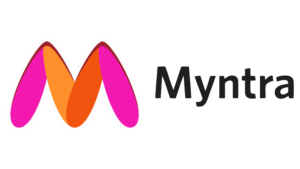How Ad Ops is Revolutionizing the Indian Advertising Landscape
Welcome to the world of ad operations, where advertising and optimization meet chaos and order, respectively. Ad operations are the foundation of the monetization strategy in the realm of digital marketing. Its function is basic. Make sure the publishers serve the right advertising at the right times. The management and optimization of digital advertising initiatives fall under this category. Ad operations have changed significantly over time. According to a 2022 forecast, revenue for ad media owners will increase by around 6% globally to a record-breaking $865 billion in 2023. As the decade progresses, it is predicted that the annual sum will rise even higher, hitting one trillion dollars by 2026.
Ad Ops is a crucial part of any publisher’s system. It is in charge of overseeing internet sales of digital advertisements and is the most profitable cash cow. In essence, it is a crucial element of ad tech. But what precisely are Ad Ops?
An Introduction to Ad Operations
Ad Ops, often referred to as Digital Ad Operations, is the term used to describe the systems and procedures that enable the management and delivery of digital advertisements. The term refers to any method used by a marketing team to manage, carry out, or improve advertising campaigns. Although there are more than a billion websites, it would be extremely expensive for advertisers to have their adverts seen by everyone around the globe. Instead, companies can attempt to target their ads at individuals who most closely match their existing customers using digital advertising markets. Here’s where ad ops come in.
They are in charge of placing the ads based on the likely audience, time zones, places, and regions. It will generate income in return through advertising initiatives. Ad operations technology links advertisers looking to buy ad space with websites that offer ad space for sale. Despite the fact that the majority of digital ad spaces are sold programmatically and without human intervention, ad operations play a significant role in setting up and overseeing these procedures.
Key Components
Ad operations is the fusion of many technological methods, tools, and stakeholders. The main categories in which the key elements of ad operations fall are:
- Ad trafficking
- Creating and managing ads
- Delivering and targeting ads
Ad Trafficking
Ad Trafficking means setting up and implementing an advertisement campaign so it runs in line with its goals.
- Scheduling – One of the crucial tasks for Ad Ops is to correctly decide and operate pre-fixed schedules for launching and running ads considering the timing of an ad is a key.
- Optimization – One of the most important benefits of digital advertising is the ability to get precise, real-time data on consumer behavior and advertising engagement.
Creating and Managing Ads
Involves choosing ad formats, developing ads, and managing marketing campaigns. To guarantee that ads are properly created and handled, ad ops specialists collaborate closely with advertisers and publishers.
Delivering and targeting ads
Professionals in ad operations employ a variety of targeting strategies, including behavioral and demographic targeting.
- Ad Performance Analytics – To optimize ad campaigns and boost performance, Ad Ops specialists track and analyze data on ad performance.
- Privacy and Ad Compliance – Ad Ops experts must make sure that ads are delivered in a way that respects user privacy and adheres to applicable laws.’
Read More: 10 Game-Changing AI Tools for Digital Marketing in 2023
Advertising Landscape in India
With cutting-edge digital technology becoming more popular than ever in the market, the Indian advertising sector is set to reach new heights. Due to the pandemic, the advertising industry has been struggling to survive the past two years. However, indications show that the Indian advertising sector has been progressively recovering. The market size was INR 743 billion in 2022, and by 2028, it is anticipated to be INR 1,412.5 billion. It has a growth rate of 11%. The Indian advertising industry is expanding at an unprecedented rate, and digital advertising is flourishing. In an effort to reach the target demographic, brands and advertisers are using agile strategies to use digital advertising.

Image credit- Research and Markets
With every second that goes by, the Indian advertising scene continues to grow. Advertising experts adopted a 360-degree strategy as technology improved to include existing and upcoming digital media. Advertising in India, a now-vast industry, is set on being the second-fastest growing advertising market in Asia. It is now more data-driven, with thorough client journeys, mass-customized messages, and attractive deals.
Benefits and Drawbacks of the Ad Ops in the Advertising Landscape

Read More: Cracking the CRED Code: A Deep Dive into its Advertising Mastery
Case Study for Brands Who Leveraged Ad Ops
In India, Zomato is a well-known B2P app for food delivery. Zomato’s excellent marketing campaign has been one of the primary causes of this enormous increase in revenue. It has made it a priority to connect with its target market consistently. Zomato grew when internet marketing became mainstream in India. For instance, appealing ad words on billboards and SMS messages to the target population showed a firm belief in their advertising skills.
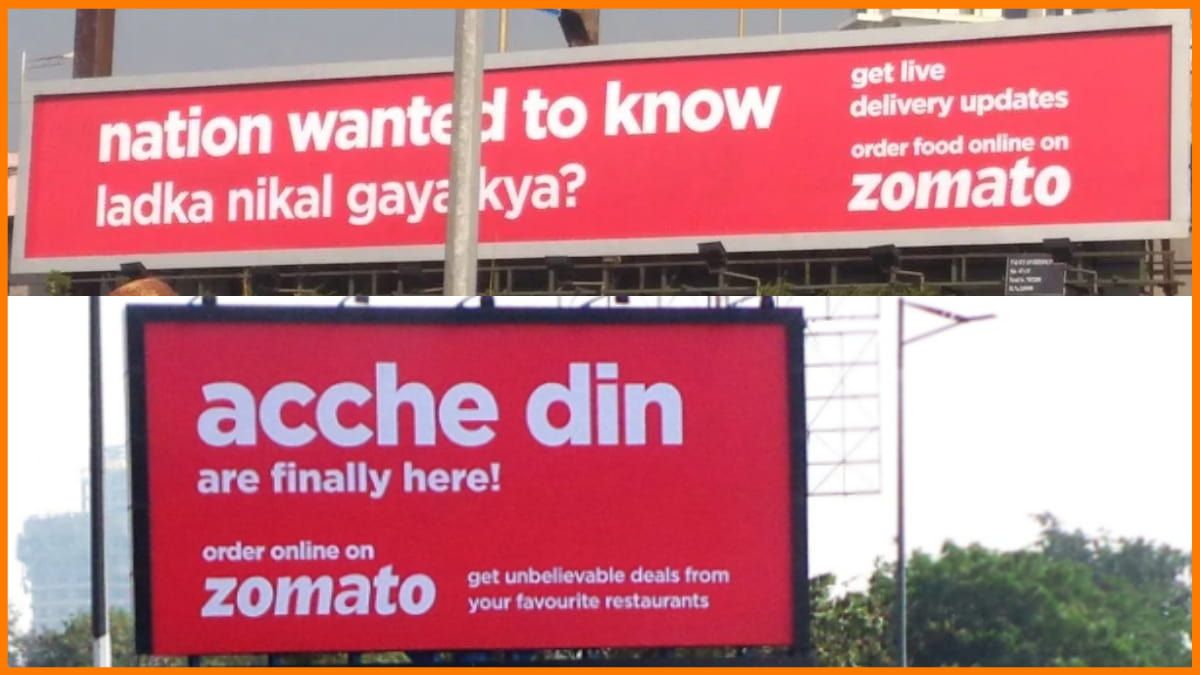
Image credit- Startup Talky
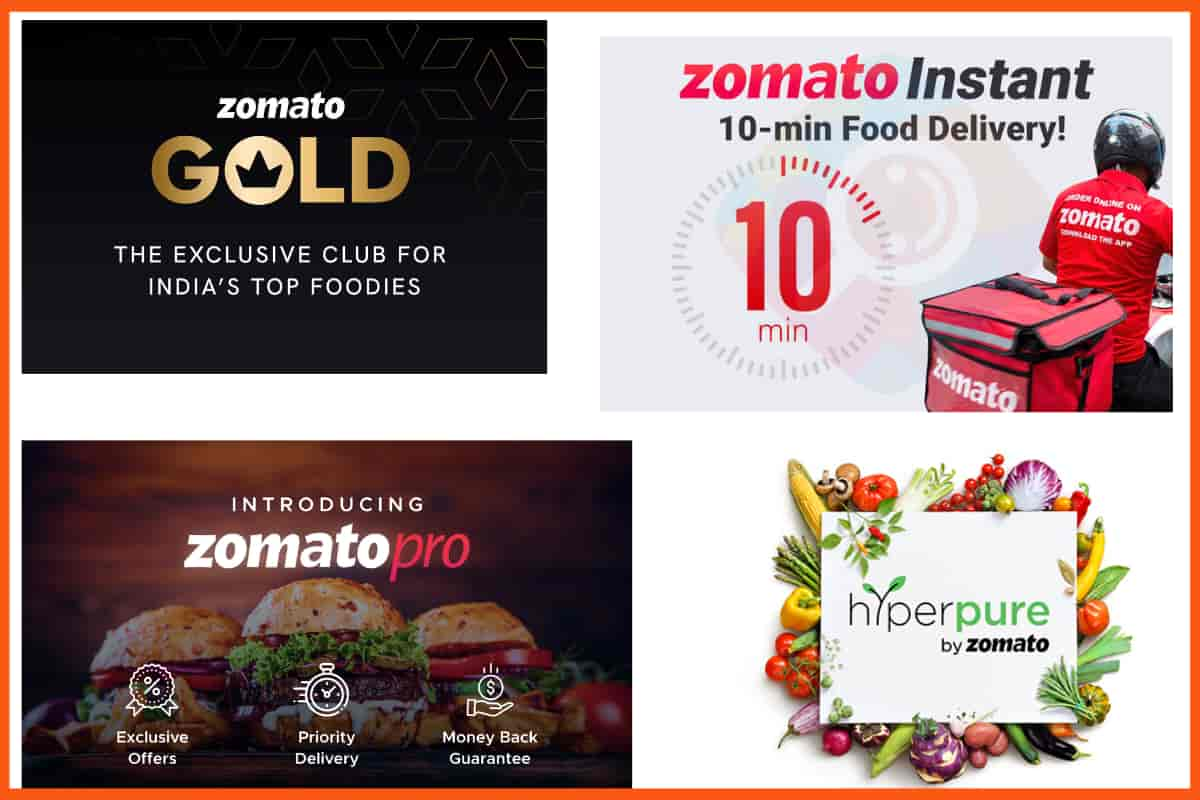
Image credit- Startup Talky
Here are some ways that Zomato’s marketing and ad operations techniques contributed to the app’s success.
- Wide-range and Powerful Outreach
- Email Tactics
- Using Social Media
- SEO Efficiency
Wide-range and Powerful Outreach
Zomato used a variety of outreach strategies in its marketing initiatives. It involves paid advertisements, email and SMS lists, and social media strategy. They studied consumer traits, ordering trends, and peak ordering hours to tailor ads for Zomato’s user base.
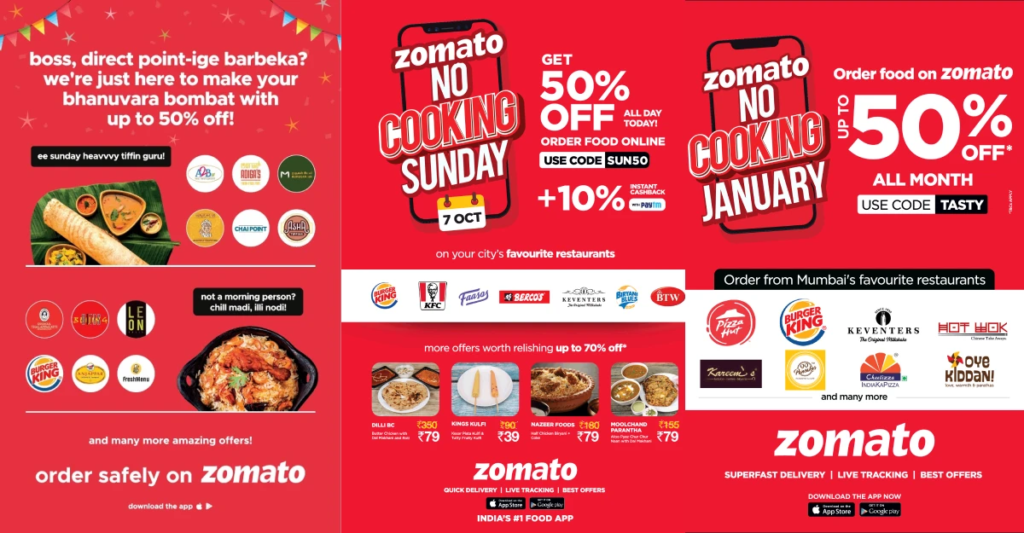
Image credit- The Business Rule
Email Tactics
Zomato targeted a potential niche by curating its emails to implement marketing strategies centered on the binge-watching culture that goes hand in hand with food.
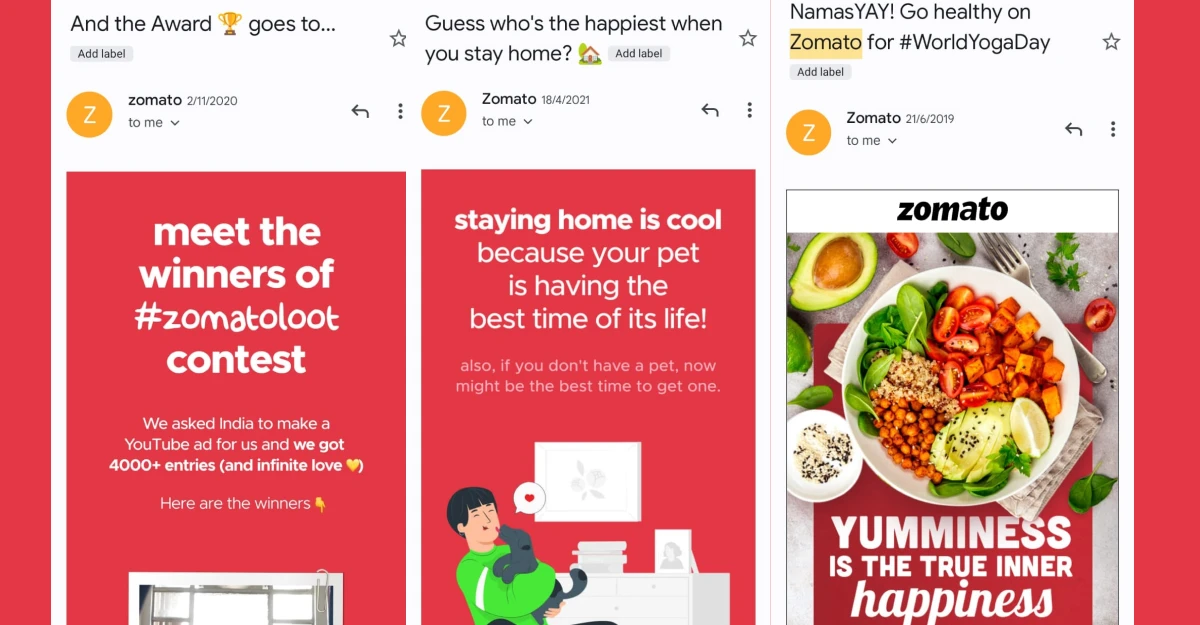
Image credit-The Business Rule
Using Social Media
Zomato depicts itself on social media with postings that are engaging on an emotional level. They interact in regional languages and make humorous memes to participate in meme

Image credit- Social Samosa via Facebook

Image credit- The Business Rule
SEO Efficiency
Zomato has produced extremely keyword-dense material that has drawn more than 67 lakh internet visitors.
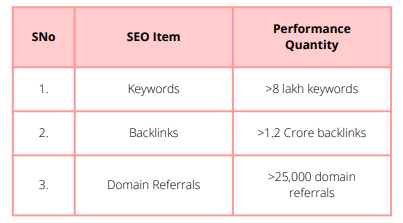
Image credit- iim skills
Zomato has a lot of influence because of its unique strategy of putting novel concepts into action on various fronts. It has always been a top priority for them to pay heed to customer comments and answer as soon as feasible.
Read More: An Innovative Triumph: Burger King x Stevenage FC Case Study
Myntra, a top-tier Indian online apparel retailer, boasts a remarkable “rags-to-riches” journey. Renowned for quality products and stellar customer service, its marketing plan revolves around key pillars for success.
- Content Marketing
- Social Media Marketing
- SEO Efficiency
- Paid Advertising
Content Marketing
Myntra has a popular blog that discusses a wide range of fashion, lifestyle, and trend-related topics. This makes the site one of the most well-liked fashion blogs in India. It leverages content marketing to establish connections with other brands and influencers.

Image credit- Myntra
Social media marketing
Myntra keeps a strong social media presence to ensure its target audience is always aware of the latest content. It routinely undertakes social media campaigns that support the development of the brand’s feeling of community. Additionally, it assists in providing a supply of user-generated material for advertising needs.

Image credit- Indian Retailer
SEO Efficiency
Myntra makes use of SEO to make sure that its website ranks as highly as possible for the right keywords. To do this, they incorporate relevant keywords and phrases into the website text.

Image credit- Madhu Sudanan via LinkedIn
Paid Advertising
Myntra promotes its website and goods through paid advertising. They employ a variety of strategies, such as display, retargeting, and pay-per-click (PPC) advertising. These techniques enable Myntra to efficiently promote its brand to a large audience.
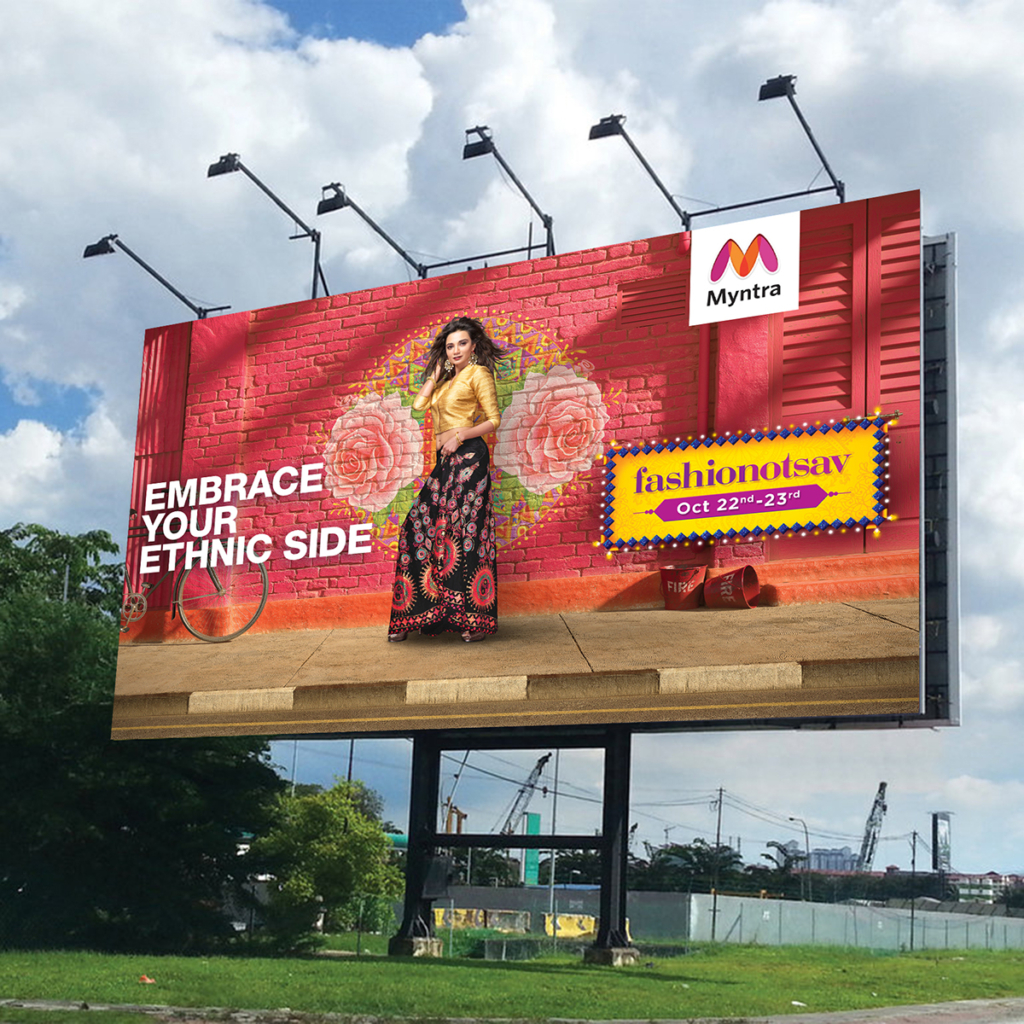
Image credit- Afaqs
Both businesses saw enormous success as a result of their marketing plans and ad operations. These businesses would still be unknown if they had not reached their target audiences at the correct time and through the right channels. Zomato and Myntra needed to avoid bombarding customers with frequent and unnecessary ads to provide an excellent customer experience. They were aware of the demographics and preferences of their audience. Both businesses achieved the ideal mix between client satisfaction and revenue generation. The organizations were able to make informed decisions due to their comprehensive insights.
The Future of Ad Ops in India
Ad operations teams will need to embrace newer platforms and follow the lead of younger demographics as the Indian advertising market continues to grow. Digital-out-of-home (DOOH) advertising tools are among the new technologies that enable marketers to reach audiences in public spaces with customized content. Moreover, it’s clear that ad operations are no longer only a tactical role. Ad operations teams are already becoming more strategic, leveraging technology to solve business challenges and playing a key role in revenue growth because of their close relationship to revenue. However since digital media is always changing, ad operations professionals should expect to face a number of new difficulties in the coming years.
- The volume of campaigns will keep growing at an exponential rate.
- The range of available ad formats will increase.
- Utilizing first-party data effectively will be essential—even more so than it is now.
- Changes in policy will be implemented on a worldwide, regional, and national scale.
- There will be more pressure on companies to maintain high margins while increasing revenue.
- Publishers will see that ad ops teams with a tech focus can directly affect revenue.
- Ad ops teams’ increased awareness of revenue workflows and data will help them move closer to the strategic side of the business.
Another important factor in digital marketing will be the development of technology. Fortunately, generative AI has made it simpler for ad operations teams to create more content in greater quantities intended for multiple channels. This technology can be used by ad operations specialists to test ad tech platforms, generate and evaluate audience segments, and produce content in a variety of formats. Ad operations teams can concentrate more on gathering information and using data-driven insights to guide marketing and revenue decisions as generative AI enhances automation.
Final Words
Ad Ops is increasingly playing a crucial role in the Indian advertising sector by enhancing efficiency, targeting, and campaign effectiveness. In this industry, automation and personalization must be carefully balanced. Ad operations will be essential in ensuring ad viewability and brand safety as the advertising landscape changes. Cheers to the growth of ad operations and their bright future in the Indian advertising industry.
Read More: Cricket’s Advertising Blitz: Boundaries Beyond the Game!
Guide On EVERY Type Of Digital Ad Out There. Case Studies Included.
What is Digital Advertising?
Digital advertising, paid advertising, or paid marketing is an online advertising model for advertisers to target potential buyers based on their interests or intent. This Digital Advertising took birth on October 27, 1994, when the online magazine ‘Hotwired’ decided to set aside a portion of its website for advertisers to raise some money. The banner ad space had a message in rainbow font, “Have you ever clicked your mouse right here? You will.” From 1994 to 2020, digital advertising has come a long way. In 2021, the amount spent on worldwide digital advertising is estimated to touch USD 375 billion (emarketer report estimates) with Google, Facebook, and Amazon, the three largest advertising platforms contributing to 43% of the market share. Here we have provided 10 best digital advertising ideas in 2020 post coronavirus (COVID-19) but be prepared to make changes in your sales funnel to meet global digital challenges. Digital advertisers get ready for a new normal in digital advertising in 2020. After all, change is the only constant in life.
Increase in Online Spending Over the Years
Ad spending in the digital advertising market has been showing an upward rise since 2018. From USD 283 billion in 2018, it is expected to reach around USD 517 billion in 2023.

Image Credits: eMarketer
The Importance of Digital Advertising
There is a wealth of available data to impact your online advertising decisions. With digital spends getting closer to traditional ad spends, it’s without doubt, every company or brand must have a strong online presence. Very large companies with more than USD 10 billion in annual revenue spend around 11.6% and companies with annual revenues between USD 500 million to USD 1 billion spend around 8.5% of their marketing budget on digital advertising. Some of the 2019 big digital ad spenders are Comcast (USD 5.75 billion), Proctor & Gamble (USD 4.39 billion), Amazon (USD 3.38 billion), AT&T (USD 3.52 billion) and Samsung Electronics (USD 2.41 billion). While on one hand, ad spending increased, on the other hand, the demand was augmented by the addition of ad platforms.

Image Credits: eMarketer

Image Credits: eMarketer
- More money is being spent on digital v/s traditional advertising channels with digital ad spend expected to reach 60.5% of total media ad spending by 2022.
- India’s digital ad spend grew at a rate of 24% (2018 to 2019), becoming the fastest-growing digital advertising market in the world, followed by Russia at 22.5%. Both are home to large populations of increasingly digital and mobile users.
- Marketing budgets range from 8% to 16% of total revenue (B2B Products 8.6%, B2B Services 8.7%, B2C Products 9.8%, and B2C Services 15.6%).
- In many countries, 85 percent of internet users are accessing the internet on mobiles.
Types of Digital Advertising
There are different types of digital advertising available to a company or product or brand. The best ad campaigns are often a mix of two or more types of paid marketing or digital advertising. From Display Ads to SEO to PPC and more, here are the top 10 online advertising options available to a digital advertiser to execute a winning ad campaign.
-
Display Advertising
What is display advertising?
Online display advertising means advertising a company or a product on websites. Display advertisements run across any website that wishes to monetize their content by selling ad space on their page. Display ads are mostly image-based ads shown on web pages within the Google Display Network (GDN is a network of websites that allow space on their web pages for Google Ads) or on a search result page. It is used to redirect the user’s attention to the company’s product. Display ads can be paid for based on three different metrics: cost per thousand impressions (CPM), cost per click (CPC), and cost per action (CPA), also known as cost per conversion.
How is the Display ad used?
Online display ads on a website, can be on the top, bottom, or right side of a page depending on the web page layout. The types of online display ads are banners, landing pages (LP’s), and popups. The types of banner ads online that appear on Google Display Network are Flash, animated GIF, and Static Banners. The most popular Display ad options are Google Shopping (allows shoppers to browse a variety of products based on their search query) and App Campaigns. The types of online Display Ads include Overlay ads, Interstitial ads, Rich Media ads, and 360° Display Ads. Display advertising and paid search advertising are the two most used forms of online advertising.
Why is display advertising important?
- Display ads are more affordable and reach a larger audience. They are used by advertisers to promote clothes, hotel chains, public events, etc.
- Website visitors who are re-targeted with display ads are 70% more likely to convert on your website.
- Display network offers advertisers contextual targeting by keywords, placement targeting by sites, topic targeting by relevance and demographic targeting based on age, gender, preferences, location and language.
- 90% of agencies and marketers believe that display ads help with branding.
- It leads to increased website traffic, and increased sales.
- These display ads can be effectively used by businesses of all sizes.

Image Credits: Pinterest
Coke’s most successful Display Ad case study
When Coca-Cola’s popularity decreased among Millennials, the brand developed the ‘Share A Coke’ campaign specifically for a Mexican audience to raise awareness and increase sales and brand love. For the campaign, Coca-Cola found the top 100 searches on YouTube and created short ads with the names of the most-searched artists, athletes, and trending YouTubers.
Coca-Cola’s website received almost two million visits during the campaign, and more than 51 percent of them came from mobile devices. View KPIs increased by 4,000 percent, and the cost per view decreased to 2 percent ofthe initial estimated budget. Additional metrics included
- 1.7 million users reached
- 81 million media impressions on display
- 175 million social media views
- 3.2 million views for the TV commercial
- CTV average of 3.98 percent during the campaign
- 80 percent of target reached
- 51 percent of website traffic from mobile devices
- 44 percent of Mexico shared a Coke
- Awareness increased 11%
-
Native Advertising
What is Native Advertising
Native Advertising called ‘recommended content’ or ‘promoted stories’ is a monetized type of advertising on a website except slightly differing from display ads in a way that attempts to mimic the format of the publisher’s content. Native advertising comprises 6 main types of ads online: in-feed (which is ad units in a content stream), recommended links, sponsored search results, promoted product listings, traditional display banners with native content, and custom integration. Most of the native pricing is on CPM basis for the campaigns.
How is the Native ad used?
Since Native advertising is designed specifically not to look like an ad, it is almost everywhere and hard to ignore. It’s designed to look like and blend with the rest of the content on the page. As a result, users interact 20-60% more with native ads than traditional banner ads. As per Google Ads, in the last four years, the search for native ads has been growing in numbers. You may notice this ad type at the bottom of a blog or a FB post. It could appear as ‘recommendations’ or ‘other people also liked’ with suggested examples for users to click on.
Why use Native Advertising?
The in-feed content in Native advertising, can include videos, animations, or carousels of images. When native ads take on the looks of the content around it, they actually become non-disruptive ads. They are found in social media in the form of sponsored posts. Also, since these ads are interactive they are the best for brand building through trust by engaging with a customer. It is an up-coming ad type mostly used by new media companies. Today native ads constitute about 20% of all advertising revenue.

Image Credits: Wordstream
The Native ad case study

Image Credits: Propeller
- Campaign: Asian Beauties from Neverblue
- Ad Copy: Would you date an Asian Woman?
- Campaign period: Mar 30, 2019 – Apr 7, 2019
- GEO: USA
- Total spent: $934
- Total Revenue: $1397
- Net profit: $463
- ROI: 50%
The advertiser worked in two stages:
– In the first stage he started with a CPC campaign to get at least 50 impressions for each ad zone. After that, added these zones to the blacklist regardless of the CTR (by clicking Zone Limitation «Exclude» in the account settings) to redirect traffic to zones that weren’t tested yet. Started with $50 and got $58 for 11 conversions. So, the profit was $8. Then decided to scale this campaign to CPM.
– In the second stage he created a CPM campaign and targeted zones with the CTR higher than 0.7% (Zone limitation “Include” in the personal account). Then he blacklisted all the under performing zones. After all the testing, he had 8 zones, with two of them generating 80% of the profit. He spent $884 and got $1339 for 255 conversions. The profit — $455
3. Search Advertising
What is Search Advertising?
Search advertising or search engine marketing (SEM), or Pay-Per-Click (PPC) is the process of advertising on search engines. Search ads are text ads displayed on Google’s search result page. Worldwide Google handles over 75,000 search queries per second. It enjoys a worldwide ranking as #1 search engine, ahead of its competitors Yahoo, Bing, and Baidu. Thereby, moving up one spot in Google’s search results can increase CTRs by up to 30.8%. Google shows your ad in the same format as other search results except that it earmarks it as an ‘Ad’. SEM is mostly combined with SEO (Search Engine Optimization is the organic and not paid form of advertising. Here, advertisers use SEO tactics, like creating keyword-friendly content, back linking, meta descriptions, etc.).
How is the Search Advertising used?
There are two search ads formats, viz. text ads and product listing ads.
- Text ads appear as ‘Ad’ above or on the right side of an organic search.
- Product listing ads (PLAs) mostly seen on e-commerce websites, show the image, price, description and link of your product when a potential customer is searching for a product based on a keyword.
These advertisements are found on search engines like Google, Yahoo!, and Bing. They are purchased based on the most relevant keywords a potential buyer uses to search for a product or service. However, recent shifts in PPC strategies are showing an increase in PLAs and ‘Semantic search’ (find meaning and or intent in the words) slowly replacing a direct keyword search.
Why search advertising?
- Paid search advertising allows advertisers to place their products/service in front of people who are already looking for the product/service.
- Since the ad is shown to potential customers who are searching for a similar product or service, there is a high chance of the user clicking on your product and converting it into a sale.
- With Google searches at 3.5 billion per day, search ads reach a larger target audience.

Image Credits: Seer Interactive
Case study of a Search Advertisement
- Client: Automotive Industry
- Goals: Reduce cost per sale from Google AdWords & Reduce monthly spend while generating more online sales.
The advertiser began with identifying the highest value conversion points, restructuring the account to only target keywords and products that would best drive the selected conversions. By understanding the way consumers buy, they could target consumers looking for specific products. They allocated an additional budget towards increasing the bids, to increase the average search position, earn a larger click share, and win the highest value auctions.

Image Credits: Web Talent Marketing
The Results:
- Increased Online Sales by 73% vs. prior year
- Deduced Cost Per Sale by 57% vs. prior year
-
Social Media Advertising
What is Social Media Advertising?
Social advertising is the use of social media sites to run an advertising campaign. By Q4 of 2019, the total number of social media users had crossed earlier estimates to reach 2.95 billion users worldwide. In 2020, that number is expected to surpass 3 billion.

Image Credits: Oberlo
How is the Social Media advertising used?
As per a recent study by Statista, the social media advertising segment amounts to USD 105,863 million in 2020 and is expected to have an annual growth rate (CAGR 2020-2024) of 6.0%, resulting in a market volume of USD 133,756 million by 2024 (not taking into account the recent coronavirus (COVID-19) implications on global trade).

The Social Media Platforms available for Advertising
Most marketers are using platforms like Facebook, Instagram, and Twitter in their marketing campaigns.

Image Credits: Xpert Digital
The other emerging platform is TikTok with 500 million active users worldwide. As per CNET, by end 2019, TikTok crossed 1.5 billion downloads, becoming the third most downloaded non-gaming app of the year, after WhatsApp and Messenger. Facebook and Instagram followed in fourth and fifth places. While grocery retailer Kroger was the first to run an ad campaign on TikTok, famous brands like TacoBell are now using TikTok.

Image Credits: Visiture
Social ads charge advertisers on a CPC, CPM and other basis. However, the pricing will depend on the different types of ads like photo ads, video ads, stories ads, carousel ads, slideshow ads, messenger ads, collection ads, snap ads, tweet ads, sponsored content, etc. Here is a quick cost comparison between the three top platforms to give you an overall idea of pricing but of course your company, your product and your brand will determine the ad budget and the social media platform allocation to maximize the profits and return on investment (ROI).

Image Credits: Webfx

Image Credits: Webfx

Image Credits: Webfx
Why is advertising on social media sites important?
- 97% of marketers use social media.
- 78% of marketers using Social Media outsell their peers.
- Social Media ads help to build brand awareness.
- The social media ad spend has risen to USD 89 billion in 2019.
- It helps to build a clientele henceforth bettering Brand Loyalty.
- Improves conversion rate.
- Reduces marketing costs as it is cheaper than traditional marketing.
- Rise in search engine rankings.
Case Study of Bajaj V’s Social Media Ad
- Campaign: SonsOfVikrant
- Objective: Promote Bajaj V – The Nation’s Bike
A ten day social media campaign run by Bajaj Automobiles, touched the minds and hearts of the whole nation as INS Vikrant one of India’s aircraft carriers was scrapped and its steel was melted and used to create the Bajaj V.
Result: Bajaj V gained 0.7 Million USD worth of free media coverage in just one week of the launch. It created 160 million impressions, reaching out to 32 million overall. And the most important one, Bajaj sold 11,000 bikes on the first day of launch. It got 984,862 views on Youtube and more than 23,000 views on Facebook.
-
Video Advertising
What is video advertising?
Video advertising is a process of running online display ads that have video within them to promote a company, product or website. These ads play before, during or after a video stream on the internet. 57% of marketers are now including video marketing in their digital marketing strategy.
How is the Video advertising used?
There are different video ad formats. The main ad formats used by YouTube, the largest video hosting platform, include TrueView Ads, Non-skippable video Ads, Bumper Ads, Outstream Ads, YouTube Masthead Ads. For more details, read about YouTube here. Video ads can be purchased on a cost per mille (CPM) basis, but are also typically priced on a cost per view (CPV) basis, allowing advertisers to pay for the ad only if someone watches or interacts with it.
Why is video advertising gaining popularity?
- Being the most engaging form of online content, video ads have higher recall.
- Video will remain a key driver of advertising expenditures on display, projected to account for 31% of overall display ad spending next year.
- More than 50% of consumers like to watch videos of the brands they support.
- In 2019, video ads saw an increase in ad spending mainly in the fashion and retail industry.
- Almost 88% of video marketers are happy with its ROI.
- As per a study by Forbes, videos get shared 1,200% more than text and links combined.
- Mobile ads on YouTube get the viewer’s attention 83% of the time.
- Everyday people watch 1 billion hours of video on YouTube.
- 90% of the potential buyers have discovered new products on YouTube
- Companies and brands like LEGO or Coca-Cola have started uploading video content on their respective brand channels.

Image Credits: Examiner
Case Study of a Video Ad
- Campaign: Meri Maggi
- Goal: Brand image
A classic example of a video ad used to regain brand image was by none other than Maggi Noodles. When the product got banned in India in 2015, its sales dipped from INR 250-300 crore a month to in between 5%-10% in various states.
In November, when the company re-launched Maggi after the five-month ban, it had 10.9 percent of the market share, which climbed to 35.2 percent in December. The relaunch campaign did include press ads and an extremely touching video launched across different platforms.
-
Pay Per Click (PPC) Advertising
What is PPC advertising?
Pay per click (PPC) ads are ads that advertisers only pay for when a user clicks on them. PPC ads are usually text ads but sometimes includes a small image. Google AdWords and Bing Ads both use a pay-per-click model.
How is the PPC advertising used?
This type of advertising is used to direct a potential buyer to your website. It is important to have a PPC landing page that is optimized for conversions. Google has now removed PPC ads from Right Hand Side so they now appear on the top of the page only.

Image Credits: WordStream
Why PPC advertising?
- PPC marketing is done through Google Ads, the worlds’ largest search engine thereby boosting the traffic to your website.
- It can deliver a large number of impressions and clicks because of the large amount of traffic, especially on Google, leading to an increase in sales.
- This type of advertising is highly successful if the advertiser has rightly focused on relevant keywords and the quality of the landing page for a higher quality score.
- Advertisers can make changes to optimize the campaign to improve the quality score which helps to increase the ROI.
- Helps to control the ad budget.
- Can improve brand recognition with remarketing.
Case study of a PPC Ad
- Campaign: Dental Clinic, London
- Goal: To increase the number of leads their ads were generating while lowering the cost per lead.
The strongest USP of this UK clinic, was the doctor a native Polish speaker. So the marketing team targeted the niche audience of Polish speakers living in London close to where the clinic is based, to create ads and select keywords in the Polish language pointing to a dedicated landing page. Constant refining of the keywords and target audience was required.

Image Credits: Exposure Ninja
Results
- In the first 50 days, the number of conversions increased considerably, up 409% from 20 to 107.
- Conversion cost came down to £7.41 from £44 (when client managed own campaign)
- The conversion rate also improved — up over 207% — from 4.38% to 13.44%.
7. Remarketing Advertising
What is retargeting advertising or remarketing?
Remarketing (or retargeting) is a type of online advertising that allows you to serve targeted ads to people who have already visited your website earlier. A remarketing ad allows you to strategically position your ads in front of the target audience as they browse Google or its partner websites, to increase brand awareness and to remind the user to make a purchase.
How do retargeting ads work?
It is a cookie-based technology that follows the user around the internet, by serving ads on the websites and platforms which the user visits most often in order to remarket to him/her again. Retargeting is required since almost 98% of users leave the website without converting on the first visit. Thereby, these 98% users need to be reminded or targeted about a product /service of interest once they leave the website. Here’s how retargeting works:

Image Credits: ReTargeter
Why Retargeting Ads?
- Retargeting increases the conversion by 150%.
- The average CTR (Click Through Rate) for Retargeting Ads is 10 times more than display ads.
- Remarketing Ads have a CPC (Cost Per Click) which is 50% that of the PPC search ads.
Case study of a Retargeting Ad
- Campaign: Jabong
- Goals: To increase transactions by acquiring more high-quality customers who are more likely to convert or make a purchase & to improve app activation rates to drive traffic to the Jabong.com mobile app and control user acquisition costs.
Jabong the e-commerce website has successfully used Facebook’s dynamic ads to retarget potential customers by showing them products they have looked at on both Jabong.com’s website and app, allowing the brand to customize ads to every individual.
Results
By Personalised Acquisition using “Retargeting” and creating custom advertisements Jabong was able to:
- 2X increase in customer acquisitions
- 5X increase in app activation rates
- 40% lower user acquisition cost on mobile app
- 30% lower cost per order
-
In-game Advertising
What is In-game advertising?
In-game advertisements are ads that may exist within computer games on desktops/PC, mobiles or tablets. In-game advertising is a digital advertising strategy provided by game developers to boost their revenue. Game developers earn money and get paid by showing the ads to the users.
How does In-game advertising work?
The ads which become a part of the user experience in a 3D game setting through virtual objects, such as, billboards, posters, or bus stops, help to improve the game app engagement and also the retention rates.
The different types of in-game advertising include –
- Dynamic In-game advertising that can be inserted or removed in real-time, inside of Console and PC video games is charged on CPM or cost per thousand impressions pricing model.
- Console Integration in the form of square tiles in the Xbox Live dashboard has a higher CPM rate.
- In the Static In-Game Advertising model where advertising is programmed directly into a game, it is normally a flat fee anywhere starting with USD 50K.
- Advergames are developed for the purpose of promoting a company, brand, or product which can run into hundreds of thousands of dollars.

Image Credits: eSoftload
Why the growing popularity of In-game Advertising?
- 62% of smartphone owners install games within the first week of purchasing a new phone.
- Games can be designed with the sole purpose of advertising a brand.
- It offers advertisers an option to position the product in the game, to reach the right audience with the right message.
- Market for in-game advertising on all devices in the US alone, to touch USD 3 billion in 2019.
- The ad spend in all games grew by 16% in 2019.
- Retargeting in gaming apps is generating revenue uplift of over 50% among paying users.
Case study of an In-game Ad

Image Credits: Gamification Plus
- Campaign: Nike Epic React
Nike named their shoe ‘Epic React’ and created a game named React Land to promote this new line of shoes in four cities. This was Nike’s idea to use gamification to attract a young target audience. After putting on a pair of Epic Reacts and creating an avatar, the player is transported to React Land, a virtual world where he/she navigates as the main character by running on a treadmill and using a handheld button to jump. In the 3-minute game, players can choose to explore a floating metropolis in China, a super soft panda land, the Fuji Mountain, a view of Santorini, a jumping frog in France and many more. After the success of this ad, Nike announced a share value increase of 7%, putting it back in direct competition with Adidas in the sneaker market.
-
Email Advertising
What is email advertising?
Email ads are interactive ads that appear in the Promotions and Social tabs of the email inbox.
How do email ads work?
Email ads are ads sent to a user via the web mail. It can include an image, video, or embedded forms. These ads are cheaper than most others. It aims to create leads, to enhance relationship with the customer, to encourage loyalty, and to grow repeat business.

Image Credits: Bannersnack

Image Credits: Bannersnack
Why Email Advertising?
- Email ads help to reach affinity audiences.
- Can customize the target audiences in Display campaigns by applying keywords.
- Offer an option of automated targeting to reach potential customers whom you wouldn’t otherwise reach, at around the same cost per person.
- You can reach people on the Display Network basis demographic categories, like age, gender, income, hobbies, etc.
- Dynamic remarketing ads are possible but the targeted Gmail ads must have a minimum of 100 active visitors or users within the last 30 days for your ads to show.
- This ad type is good for promotions, new features, and discount offers.
- An Email ad looks organic prompting the user to click.
Case Study of an email advertising campaign
- Campaign: Wok to Walk
- Goal: Local customer creation, Brand Awareness

Imaage Credits: Neil Patel

Image Credits: Neil Patel
Wok to Walk, a health food company, sent a newsletter with a subject line that invited recipients to call, make inquiries and order a meal. This email generated an open rate of 18.1%. Next step they checked the statistics and selected email subscribers who didn’t open the previous email.
The same email was sent – but the subject line was changed to better suit this new segment by including a phone number, making it easier for people to call even if they didn’t open the email. This second email received 7.7% additional subscribers, resulting in a higher level of email engagement.
-
Mobile Advertising
What is mobile advertising?
Today with mobiles becoming a quintessential part of our lives, mobile advertising is growing in importance. Mobile advertising is placing ads to run specifically on mobile devices such as cell phones, smartphones, tablets, and wearable technology with the use of enhanced campaigns. Marketers often combine mobile advertising with other digital advertising channels like display advertising, search advertising, social media advertising, and video advertising.
How do mobile ads work?
Mobile advertising is targeted. It allows the advertiser to personalize the content for a specific audience. When Samsung wanted to promote its Galaxy S6 smartphone, they created an interactive mobile ad for people to experience what the company was talking about with a demo on their smartphone. The other winning mobile ads are Ruffles potato chips, GAP remix logo launch, Nissan Rogue SUV launch, and Starbucks.

Image Credits: Mobile Ads
Why is mobile advertising or mobile marketing important in 2020?
- Global mobile ad spending in 2019 reached USD 190 billion.
- In India, mobile ad spending is expected to rise from approx. USD 460 million to USD 1.73 billion in 2021.
- 29% of the time is spent on desktops and 71% on mobile devices
- 80% of internet users own a smartphone.
- 70% of B2B buyers increased mobile usage over the past years.
Case Study of a video ad
- Campaign: Pay Attention
- Goal: Create Awareness
In 2018, cosmetic brand Avon India aimed to raise awareness about breast cancer among women in India through its #PayAttention campaign. Avon had a breast self-examination (BSE) video for women to help them identify the signs of breast cancer.
Results
- 15 % SOV and awareness in breast cancer
- Reached over 1 billion people of India at USD 25k
- On social media, Avon reached out to 917 million on Facebook, 101 million on Twitter, 109 Million through PR stories and 29 influencer videos with 36 million impressions.
- #PayAttention was top trending hashtags around Breast Cancer Awareness in India.
- 200,000 interactions were created on FB and near 185,000 interactions on Facebook posts.
Conclusion
The coronavirus (COVID-19) has disrupted our world, our thinking, and our way of doing business. This impact will surely be felt by every company, big or small. Once the global crises passes, there will be renewed spending on digital platforms to adapt rapidly to the new normal. This new normal stage requires new advertising strategies and new execution plans across all channels. With a fair idea on paid advertising, it’s time to get ready to leverage the right ads for your company or brand when the time is right. How to establish new goals to maximize the ROI, how to rework ad budgets, how to re-prioritize the channel amplification, how to pivot from the standard content marketing plan, how to target all devices buyers use, are all questions a digital advertiser will need to be prepared with. There will never be a right or wrong answer but always an in-between that is the ‘right fit’. We have only put you on a fast track to think on the right lines to restrategize your digital advertising campaign. Time to work on it further!
Summary
Coronavirus (COVID-19) will bring about deep changes in digital advertising. Ad revenues, social media, e-commerce will impact Google Ads, Social Media ads, affiliate earnings and publisher advertising earnings. Digital advertisers will require to get ready for a new normal in paid advertising from 2020. In this blog, we have tried to contain maximum information and some relevant statistics on digital advertising. There will never be a right or wrong answer but always an in-between that is the ‘right fit’. We have only put you on a fast track to think on the right lines to restrategize your digital advertising campaign. Time to work on it further!



